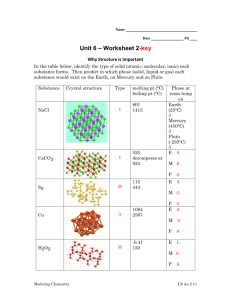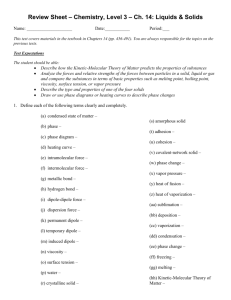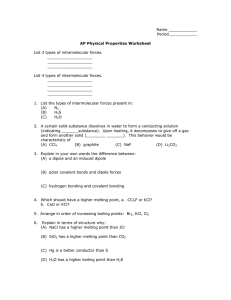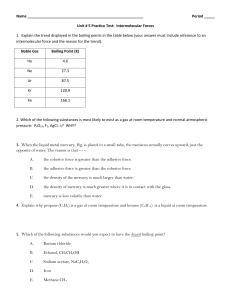Review for Ch 10 and 11 - OPHS-AP
advertisement
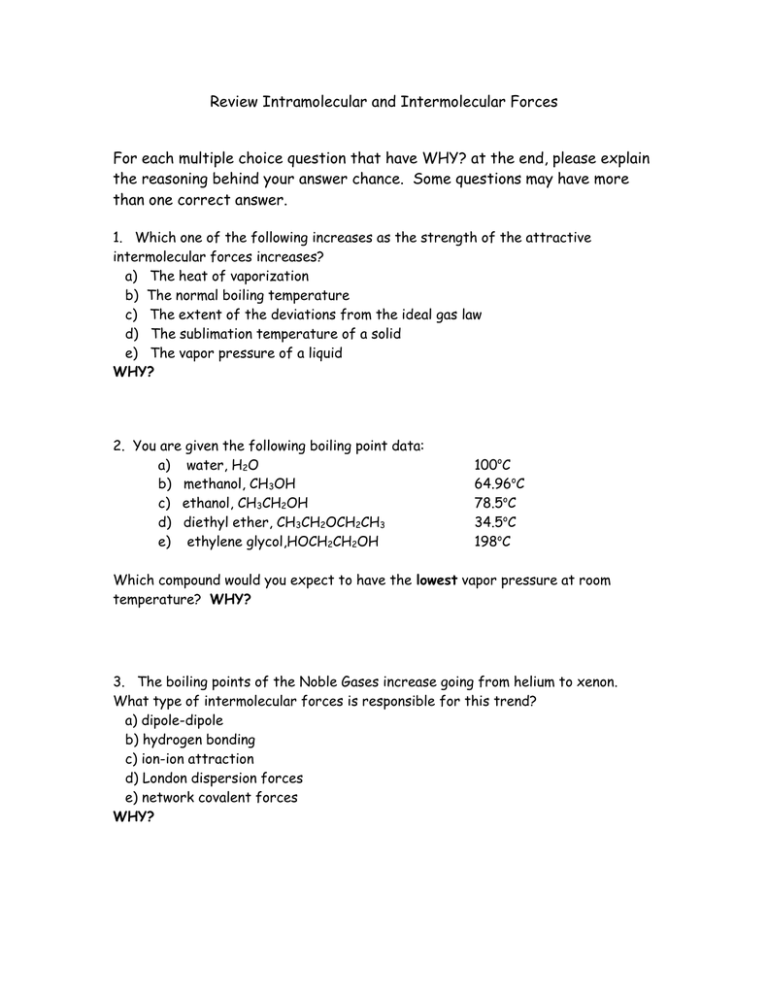
Review Intramolecular and Intermolecular Forces For each multiple choice question that have WHY? at the end, please explain the reasoning behind your answer chance. Some questions may have more than one correct answer. 1. Which one of the following increases as the strength of the attractive intermolecular forces increases? a) The heat of vaporization b) The normal boiling temperature c) The extent of the deviations from the ideal gas law d) The sublimation temperature of a solid e) The vapor pressure of a liquid WHY? 2. You are given the following boiling point data: a) water, H2O b) methanol, CH3OH c) ethanol, CH3CH2OH d) diethyl ether, CH3CH2OCH2CH3 e) ethylene glycol,HOCH2CH2OH 100oC 64.96oC 78.5oC 34.5oC 198oC Which compound would you expect to have the lowest vapor pressure at room temperature? WHY? 3. The boiling points of the Noble Gases increase going from helium to xenon. What type of intermolecular forces is responsible for this trend? a) dipole-dipole b) hydrogen bonding c) ion-ion attraction d) London dispersion forces e) network covalent forces WHY? 4. Which one of the following boils at the highest temperature? a) CF4 b) HF c) Cu d) KI e) SiF4 WHY? 5. Which of the following is a correct listing in terms of decreasing boiling point? a) CCl4 > CH4 > H2O > H2S b) CH4 > CCl4 > H2S > H2O c) H2O > H2S > CH4 > CCl4 d) H2S > H2O > CCl4 > CH4 e) H2O > H2S > CCl4 > CH4 WHY? 6. Describe London Dispersion forces, dipole-dipole attraction, and hydrogen bonding. Include in your discussion the characteristics, which affect the magnitude of each force (ie why does LDF change) and how each characteristic affects the magnitude. 7. In which of the following processes are covalent bonds broken? a) melting benzene b) combustion of CH4 c) melting H2O d) boiling C2H5OH WHY? 8. In which process are the strongest bonds/forces being broken/overcome? a) melting ice b) melting iodine c) boiling CCl4 d) melting NaCl WHY? 9. Demonstrate the difference between intramolecular and intermolecular using water. (10 pt) Review for Heating Curve Heating Curve. 1. Consider the following information for substance Q: Hvap Hfus 40 kJ/mol 10 kJ/mol bp mp 60°C 0°C C(s) C(l) C(g) 2.0 J/g°C 8.0 J/g°C 4.0 J/g°C A. Sketch the proportional heating curve for this substance starting at -10°C? Briefly explain the significance of the plateaus and slopes. (10pt) B. How much energy (in Joules) does it take to convert all of 0.333 kg of solid substance Q at -5°C to a vapor that is at 80°C? Substance Q has a molar mass of 45.0g/mol. (Read the questions carefully) (20pt) Review for Solids and their Properties 1. How do ionic solids, molecular solids and atomic solids differ in their construction? (What do you find at their lattice points?) Please draw an example of each. 2. Classify as metallic, molecular, ionic or network covalent a solid that a. b. c. d. e. f. is a nonconductor but conducts when melted dissolves in water to give a non-conducting solution melts below 100°C and reacts violently with water conducts electricity as a solid melts below 100°C to a give a non-conducting liquid dissolves in water to a give a conducting solution 3. Of the four general types of solids which one(s) a. b. c. d. e. f. are generally insoluble in water are very high melting conduct electricity as solids are generally low boiling are ductile and malleable are generally nonvolatile 4. Classify the following species as being ionic, molecular, network covalent or metallic at 25°C and 1 atm: a. b. c. d. e. PCl3 SiC Bromine MgO Chromium f. tungsten g. IBr h. quartz i. iron (III) nitrate j. carbon dioxide

